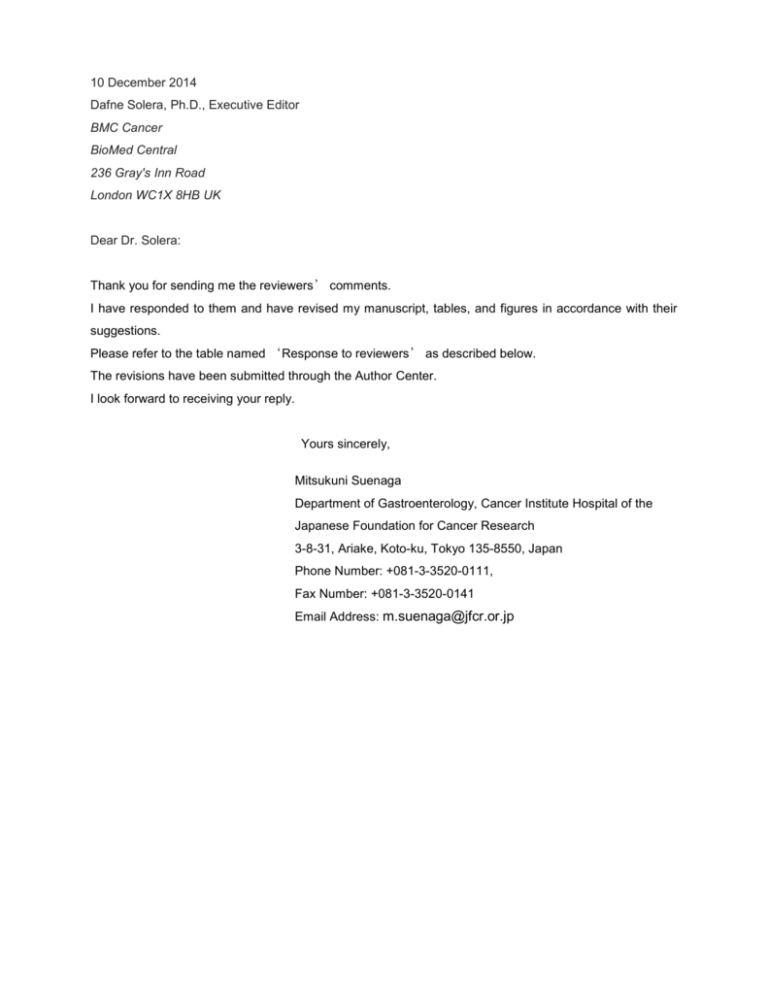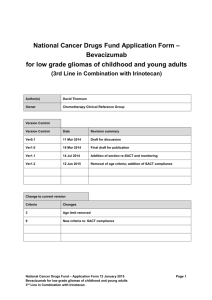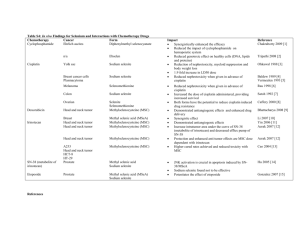10 December 2014 Dafne Solera, Ph.D., Executive Editor BMC
advertisement

10 December 2014 Dafne Solera, Ph.D., Executive Editor BMC Cancer BioMed Central 236 Gray's Inn Road London WC1X 8HB UK Dear Dr. Solera: Thank you for sending me the reviewers’ comments. I have responded to them and have revised my manuscript, tables, and figures in accordance with their suggestions. Please refer to the table named ‘Response to reviewers’ as described below. The revisions have been submitted through the Author Center. I look forward to receiving your reply. Yours sincerely, Mitsukuni Suenaga Department of Gastroenterology, Cancer Institute Hospital of the Japanese Foundation for Cancer Research 3-8-31, Ariake, Koto-ku, Tokyo 135-8550, Japan Phone Number: +081-3-3520-0111, Fax Number: +081-3-3520-0141 Email Address: m.suenaga@jfcr.or.jp Response to reviewers BMC Rev.1 Major1 Comment Response The authors decided to exclude from the study Enrollment in this study was limited to patients of the wild-type patients with a UGT1A1* 28 or UGT1A1*6 or heterozygous group for UGT1A1*28 and *6 polymorphisms genotypes or compound heterogzygous due to to ensure the safety of subjects based on the following: as their higher risk of developing toxicity. This described on page 7, line 13 Satoh et al. reported that represents a limit for the study that should be irinotecan could be used safely in Japanese patients of the wildacknowledged. type or heterozygous for UGT1A1*28 and *6 polymorphisms; In fact American and European guidelines for and the approved dose of irinotecan for Japanese patients is pharmacogenetic testing (ww.pharmgkb.org/ 150mg/m2. Dutch Pharmacogenetics Working Group) recommend to use a 25% reduction of irinotecan As you pointed out, this regimen with a reduced starting dose dose in these patients instead of not treating the of irinotecan may provide an antitumor benefit for Japanese patients. patients homozygous for UGT1A1*28 and *6 polymorphisms. These patients could by the way be at higher Thus, our study future prospectives have been additionally chance of tumor response according to some described in the sentence on page 22, line 11, “ We consider it authors. I would consider to extend the study also necessary in future to determine appropriate doses irinotecan to this class of patients, with a 25% lower starting and evaluate the efficacy and safety in Japanese patients of the dose, at least as study future perspectives. homozygous group for UGT1A1*28 and *6 polymorphisms.”. Rev.1 Major2 I would perform an additional statistical analysis to compare the outcome of patients who discontinued first line treatment for toxicity or for tumor progression “The outcome of patients who discontinued first line treatment for toxicity or for tumor progression” has been additionally described in the paragraph starting on page 16, line 14, ” The outcome was compared between patients who discontinued the first-line oxaliplatin-based treatment due to progression of the primary disease and those who discontinued it due to adverse events: the response rate, PFS, and OS were 8.7% (95% CI: 2.4-20.8%), 3.8 months (95% CI: 2.5-4.7 months) and 12.4 months (95% CI: 8.9-15.1 months), respectively, in the former, while they were 11.6% (95% CI: 3.9-25.1%), 6.6 months (95% CI: 5.6-9.4 months) and 17.0 months (95% CI: 12.7-23.3 months), respectively, in the latter.”. Rev.1 Major3 When performing a statistical analysis to compare PFS and OS between patients pre-treated or not pre-treated with bevacizumab the authors should perform a multi-variate analysis including covaraites as age, sex, PS, tumorsite,…. In the OS analysis they should also add as a co-variate the post-FOLFIRI/beva treatment. The results of Cox multivariate regression analysis including age, sex, PS, primary tumor site and pre-treatment or not pretreatment with bevacizumab as covariates have been added on page 16, line 10, “ Additional multivariate analysis including sex, age, ECOG PS, primary tumor site, and pre-treatment with bevacizumab as covariates resulted in HR for OS of 3.773 (p<0.001) and for PFS of 2.237 (p=0.008).”. Despite your recommendation, “the post-FOLFIRI/beva treatment” was not included as a covariate in the OS analysis because it was a time-dependent covariate and may have been affected by the effect of treatment due to the study regimen itself, making it difficult to interpret the result. Rev.1 The outcome of beva pre-treated patients is quite Discretionary worse than for not pre-treated patients and this 1 could be a limitation for the treatment of these patients. This in my opinion should be highlighted in the study conclusion Investigation of possible differences in efficacy with and without bevacizumab pre-treatment was an exploratory objective of this study. Thus, this point is described in the Discussion (page 20, line 1) rather than in the Conclusion. Rev.1 In the discussion when mentioning Kras tumor We cannot mention Nras, Braf, PI3K and PTNE loss because Discretionary status the authors could consider also other well these markers were not determined in this study. 2 acknowledged prognostic tumor markers for CRC as Nras, Braf status, PI3KCA and PTNE loss Editorial Request 1.) Kindly include the full names of the Institutional Review Boards that approved study - Please update your ethics statement to include the name of the ethics committee that approved your study. Is it absolutely necessary to include the full names of all IRBs that approved this study? This was a multicenter study and was approved by the IRB of each participating institution as clearly described in the section of Methods.











